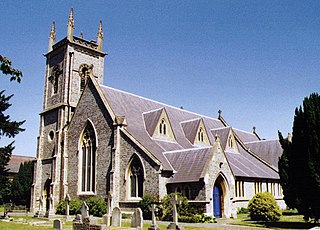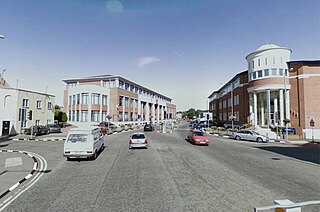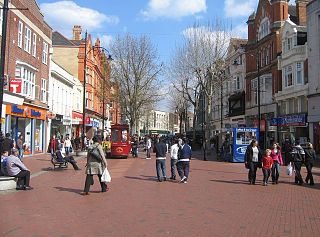
Reading is a historic market town in Berkshire, England, in the Thames Valley at the confluence of the River Thames and Kennet. It is on the Great Western Main Line railway and the M4 motorway, 40 miles (64 km) east of Swindon, 25 miles (40 km) south of Oxford, 40 miles (64 km) west of London, 15 miles (24 km) north of Basingstoke, 13 miles (21 km) southwest of Maidenhead and 15 miles (24 km) east of Newbury.

Reading Abbey is a large, ruined abbey in the centre of the town of Reading, in the English county of Berkshire. It was founded by Henry I in 1121 "for the salvation of my soul, and the souls of King William, my father, and of King William, my brother, and Queen Maud, my wife, and all my ancestors and successors." In its heyday the abbey was one of Europe's largest royal monasteries. The traditions of the Abbey are continued today by the neighbouring St James's Church, which is partly built using stones of the Abbey ruins.

Berkshire is a county in South East England. One of the home counties, Berkshire was recognised by the Queen as the Royal County of Berkshire in 1957 because of the presence of Windsor Castle, and letters patent were issued in 1974. Berkshire is a county of historic origin, a ceremonial county and a non-metropolitan county without a county council. The county town is Reading.

Wokingham is a market town in Berkshire, England, 37 miles (60 km) west of London, 7 miles (11 km) southeast of Reading, 8 miles (13 km) north of Camberley and 4 miles (6 km) west of Bracknell. The town is a constituent part of the Reading/Wokingham Urban Area.
The Queens Public Library (QPL), also known as the Queens Borough Public Library and Queens Library (QL), is the public library for the borough of Queens, and one of three public library systems serving New York City. It is one of the largest library systems in the world by circulation, having loaned 13.5 million items in the 2015 fiscal year, and one of the largest in the country in terms of the size of its collection. According to its website, the library holds about 7.5 million items, of which 1.4 million are at its central library in Jamaica, Queens. It was named "2009 Library of the Year" by Library Journal.

Earley is a town and civil parish in the English county of Berkshire. Along with neighbouring town of Woodley. The Office for National Statistics places Earley within the Reading/Wokingham Urban Area; for the purposes of local government it falls within the Borough of Wokingham, outside the area of Reading Borough Council. The name is sometimes spelt Erleigh or Erlegh. The suburb consists of a number of smaller areas, including Maiden Erlegh and Lower Earley, and lies some 3 miles (5 km) south and east of the centre of Reading, and some 4 miles (6 km) northwest of Wokingham. It has a population of around 32,000. In 2014, the RG6 postcode area was rated one of the most desirable postcode areas to live in England. The main campus of the University of Reading, Whiteknights Park, lies partly in Earley and partly in the borough of Reading.

Chertsey is a town in the Borough of Runnymede, Surrey, England, 29 km (18 mi) south-west of central London. It grew up round Chertsey Abbey, founded in 666 CE, and gained a market charter from Henry I. A bridge across the River Thames first appeared in the early 15th century. The River Bourne through the town meets the Thames at Weybridge. The Anglican church has a medieval tower and chancel roof. The 18th-century listed buildings include the current stone Chertsey Bridge and Botleys Mansion. A curfew bell, rung at 8 pm on weekdays from Michaelmas to Lady Day ties with the romantic local legend of Blanche Heriot, marked by a statue of her and the bell at Chertsey Bridge. Green areas include the Thames Path National Trail, Chertsey Meads and a round knoll with remains of a prehistoric hill fort known as Eldebury Hill. Pyrcroft House dates from the 18th century and Tara from the late 20th. Train services are run betweenChertsey railway station and London Waterloo by South Western Railway. The town is within the M25, accessible via junction 11.

Ascot is a town in the Royal Borough of Windsor and Maidenhead in Berkshire, England. It is 6 miles (9.7 km) south of Windsor, 4 miles (6.4 km) east of Bracknell and 25 miles (40 km) west of London. It is most notable as the location of Ascot Racecourse, home of the Royal Ascot meeting, and is reportedly the 13th most expensive town in England when taking into account the average house price, which stands at £1,019,451 as of June 2021. It is also among the ten most expensive towns in Britain to rent a property. The town comprises three areas: Ascot itself, North Ascot and South Ascot. It is in the civil parish of Sunninghill and Ascot.

Sainte-Geneviève Library is a public and university library located at 10, place du Panthéon, across the square from the Panthéon, in the 5th arrondissement of Paris. It is based on the collection of the Abbey of St Genevieve, which was founded in the 6th century by Clovis I, the King of the Franks. The collection of the library was saved from destruction during the French Revolution. A new reading room for the library, with an innovative iron frame supporting the roof, was built between 1838 and 1851 by architect Henri Labrouste. The library contains around 2 million documents, and currently is the principal inter-university library for the different branches of University of Paris, and is also open to the public.

Reading Museum is a museum of the history of the town of Reading, in the English county of Berkshire, and the surrounding area. It is accommodated within Reading Town Hall, and contains galleries describing the history of Reading and its related industries, a gallery of artefacts discovered during the excavations of Calleva Atrebatum, a copy of the Bayeux Tapestry, finds relating to Reading Abbey and an art collection.

The Mugar Memorial Library is the primary library for study, teaching, and research in the humanities and social sciences for Boston University. It was opened in 1966. Stephen P. Mugar, an Armenian immigrant who was successful in the grocery business, provided the naming gift to commemorate his parents. Mugar's entrance carries an inscription from Stephen honoring his parents.
In coming to America from Armenia my parents opened the door of Freedom to me. America's public schools & libraries opened my eyes to the unlimited opportunity in this great land, as well as the privileges and obligations of citizenship. May this library serve over the years as a similar inspiration to all who use it. In memory of my father and mother Sarkis and Vosgitel Mugar. By their grateful son
– Stephen P. Mugar –

The Berkshire Athenaeum is a public library (1872) based on a previously private athenaeum, and now at 1 Wendell Avenue, Pittsfield, Massachusetts in the Berkshires, United States. Like many New England libraries, the Berkshire Athenaeum started as a private organization.

The Huntington Free Library is a privately endowed library near Westchester Square in the New York City borough of the Bronx, which is open to the public. It has a non-circulating book collection.

The Lenox Library is the principal public library of Lenox, Massachusetts. It is managed by the non-profit Lenox Library Association, founded in 1856, and is located at 18 Main Street, in a former county courthouse that is listed on the National Register of Historic Places.

Broad Street is a main pedestrianised thoroughfare and the primary high street in the English town of Reading. The street is situated in the town centre, running for approximately 0.25 miles (0.40 km), from west to east. The western end of the road lies at the crossroads with Oxford Road, West Street and St Mary's Butts. The eastern end continues as King Street after the junction with Minster Street and Butter Market.

Public libraries in Cardiff are owned and operated by Cardiff Council. There are 20 public libraries in the capital of Wales, the largest of which is Cardiff Central Library. A mobile library service is also provided. In 2018/19, there were almost 91,000 Cardiff residents, around 25% of the city's population, who borrowed an item from a municipal library. Increases in visits, active borrowers and library members have taken place during 18/19 as the service continues to grow in popularity with Cardiff's citizens.

Leeds Central Library is a public library in Leeds. Situated in the city centre, on Calverley Street, it houses the city library service's single largest general lending and reference collection and hosts the Leeds Art Gallery.

Reading Town Hall is the town hall in the town of Reading, in the English county of Berkshire. The town hall was built in several phases between 1786 and 1897, although the principal facade was designed by Alfred Waterhouse in 1875. Situated close to the site of Reading Abbey, it is adjoined to the north by the Hospitium of St John and to the south by St Laurence's Church.
Occupation at the site of Reading may date back to the Roman period, possibly as either a trading port on the River Thames, or as an intersection on the Roman road connecting London with Calleva Atrebatum near Silchester.

The Hospitium of St John the Baptist was the hospitium, or dormitory for pilgrims, of Reading Abbey, which today is a large, ruined abbey in the centre of the town of Reading, in the English county of Berkshire. The hospitium was founded in 1189, and at its maximum comprised a range of buildings that could accommodate 400 people. The main building has survived, and is grade II listed. Much of the remainder of the original hospitium was located where Reading Town Hall now stands.



















